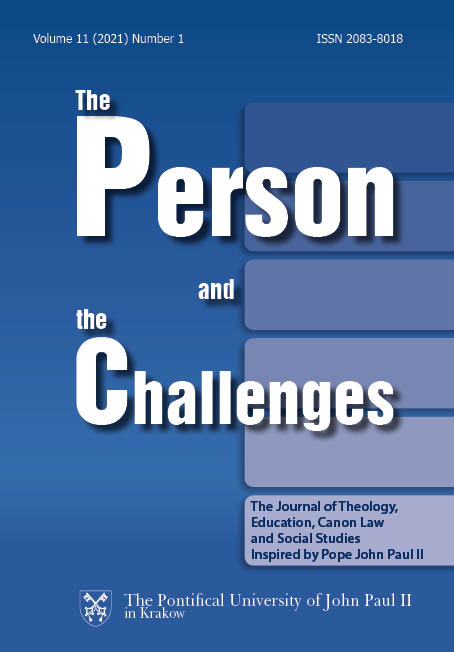The Process of Creating a Digital Communication Model for the Vatican
DOI:
https://doi.org/10.15633/pch.3887Słowa kluczowe:
Digital communication, Internet, IT, social communication, social studies, VaticanAbstrakt
In 1978, in the Holy See, all communication took place thanks to the analogue technology of text, sound and image recording. In the following years, the progress in computer science, made it possible to save any kind of data in the form of digital recording, so that one could collect data and transfer it to any place in an instant. Digitalization also allowed the Vatican to create a new model of communication with the modern world. This model was first based on the capabilities of computer networks and then on the Internet. It was first tested by the Holy See in Latin America. The experience of the Latin American Church’s Computer Network (RIIAL) was transferred to the Vatican, and then developed and proposed by John Paul II to the entire Universal Church. This model of digital communication would not have been possible without collaborators such as John Patrick Foley, Judith Zoebelein, Joaquin Navarro-Valls and a group of lay Catholics and clergy from Latin America. It was thanks to them that the Holy See began to communicate digitally through the World Wide Web and to use e-mail in a relatively short time since their invention. The present analysis concerns the creation of a digital model of communication during the pontificate of John Paul II (1978–2005).The inclusion of social media in the communication model of the Vatican, took place during the successors of the Pope from Poland.
Bibliografia
Campbell H. A., Vitullo A., Popes in Digital Era. Reflecting on the Rise of the Digital Papacy, „Problemi dell’informazione” 3 (2019), pp. 419–442.
Campbell H., Preface, in: Arasa D., Cantoni L., Ruiz L. A. (eds.), Religious Internet Communication. Facts, Trends and Experiences in the Catholic Church, Rome 2010, pp. 9–11.
Foley J. P., Internet Gives New Meaning to «Deus ex Machina», https://zenit.org/2001/06/07/archbishop-foley-s-address-for-communications-day/ (5.07.2020).
Foley J. P., Una Red Informática de la Iglesia: Identidad y desafíos, https://www.es.catholic.net/op/articulos/6180/cat/363/una-red-informatica-de-la-iglesia-identidad-y-desafios.html#modal (28.08.2020).
Gęsiak L., Reform of the Vatican media, a difficult search for a new path, „The Person and the Challenges” 7 (2017) 2, pp. 5–22.
Historia de la RIIAL explicada hoy, http://www.riial.org/historia-de-la-riial-la-red-informatica-de-la-iglesia/ (5.07.2020).
Hoyos D. C., El sacerdote y la informatica, https://es.catholic.net/op/articulos/6173/cat/45/el-sacerdote-y-la-informatica.html#modal (12.01.2021).
John Paul II, The Rapid Development, http://www.vatican.va/content/john-paul-ii/en/apost_letters/2005/documents/hf_jp-ii_apl_20050124_il-rapido-sviluppo.html (28.08.2020).
John Paul II, The Christian Message in a Computer Culture. Message for the 24th World Communications Day 1990, http://www.vatican.va/content/john-paul-ii/en/messages/communications/documents/hf_jp-ii_mes_24011990_world-communications-day.html (5.07.2020).
KAI, Stolica Apostolska w Internecie, https://kair.ekai.pl/depesza/23404/show?q=%-
Stolica%20Apostolska%20w%20Internecie%22 (24.07.2021).
Maaike M. A., La Santa Sede e la Comunicazione, Utrecht 2013.
Mora S., Navarro-Valls Was Able to Manage the Internet Revolution in the Vatican, https://zenit.org/2017/07/06/navarro-valls-was-able-to-manage-the-internet-revolution-in-the-vatican-says-greg-burke (26.08.2020).
Planas E., Una red informática para la comunion eclesial, https://es.catholic.net/op/articulos/20996/cat/156/horizontes-eclesiales-en-informatica.html#modal (14.01.2021).
Seeing the Spirit at work in the world, http://vision-vocation-guide.blogspot.com/2006/11/sister-judith-zoebelein-developer-of.html (16.01.2021).
Soberón M. L., Collaborative intelligence. How to make our human-sized digital key conversations for transforming organizations smarter, „Psychology and Cognitive Sciences Open Journal” 4(2) (2018), pp. 48–51.
Soberón M. L., La inteligencia conectiva en la Red Informática de la Iglesia en América Latina (RIIAL), „Signo y Pensamiento” 28 (54) (2009), pp. 300–316.
Staley T., Surf’s up. Vatican website serves as an important resource since Pope John Paul OK’d it, https://www.thecompassnews.org/compass/2003-08-22/editorial1.shtml (23.01.2021).
Storia del Dicastero per la Comunicazione, https://www.comunicazione.va/it/chi-siamo/storia.html (16.08.2020).
Trigilio J. Jr., Brighenti K., Toborowsky J., John Paul II for Dummies Special Edition, Hoboken 2015.
Valentan S., I tre Papi e la necessita degli strumenti di comunicazione sociale nella Chiesa, „Bogoslovni vestnik” 79 (2019) Nr 4, pp. 1075–1086.
Vaujany F-X. de, Between eternity and actualization. The co-evolution of the fields of communication in the Vatican, „Communications of the Association for Information Systems” 18 (2006), pp. 355–391.
Vaujany F-X. de, Conceptualizing I.S. Archetypes Through History. A Study of the Roman Curia, in: ICIS 2006 Proceedings Paper 83, pp. 1341–1356.
Ysern de Arce J. L., Elementos básicos para una pastoral de la informática y de las nuevas tecnologías de la comunicación social, Brasília 1995.
Zoebelein J., The Vatican, in: Arasa D., Cantoni L., Ruiz L. A. (eds.), Religious Internet Communication. Facts, Trends and Experiences in the Catholic Church, Rome 2010, pp. 139–144.
Pobrania
Opublikowane
Numer
Dział
Licencja
Autorzy publikujący w czasopiśmie udzielają jego wydawcy zgody o następującej treści:
- Autor zachowuje autorskie prawa majątkowe do utworu, a jednocześnie udziela wydawcy czasopisma zgody na jego pierwszą publikację w wersji drukowanej i wersji online na licencji Creative Commons Uznanie autorstwa 4.0 Międzynarodowe oraz zgody na wykonywanie opracowań, w tym przekładów.
- Autor ma możliwość udzielania zgody niewyłącznej na opublikowanie utworu w wersji, która ukazała się w czasopiśmie (np. zamieszczenia go w repozytorium instytucjonalnym lub opublikowania w książce), wraz z informacją o jego pierwszej publikacji w czasopiśmie.
- Autor może umieścić swój utwór online (np. w repozytorium instytucjonalnym lub na swojej stronie internetowej) jeszcze przed zgłoszeniem utworu do czasopisma.

